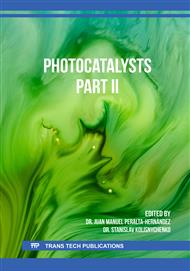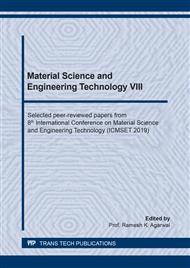p.48
p.55
p.61
p.71
p.78
p.84
p.90
p.96
p.102
Effect of Anatase/Rutile Phase Ratio on the Photodegradation of Methylene Blue under UV Irradiation
Abstract:
Titanium dioxide (TiO2) is known as one of the widely used catalysts in photocatalysis process. Recently, the photocatalysis of TiO2 has been implied in water purification and treatment, particularly dyes and organic compounds degradations. Naturally, the TiO2 can be found in three phases including anatase, rutile and brookite; each phase has its own specific properties such as grain size, stability and band gap energy. In this work, the effect of calcination temperature on the structure, morphology and photocatalytic activity were investigated. The data suggested that the anatase/rutile ratio of TiO2 can be controlled through the calcination process. The phase transformation data strongly indicated the liner function between percentage of rutile phase and calcination temperature. The BET analysis provided the consistent data with XRD patterns by showing that the specific surface area was decreased by increasing calcination temperature. The photodegradation of methylene blue under UV irradiation proved that the mixed phase of anatase/rutile ratio at 78.5/21.5 provided the highest photocatalytic activity. The phase composition ratio can influence the nanoparticles properties including band gap, specific surface area and energy band structure. Therefore, the control of anatase/rutile ratio was an alternative to enhance the photocatalytic activity of TiO2 nanoparticles for dyes and organic compounds degradations.
Info:
Periodical:
Pages:
78-83
Citation:
Online since:
June 2020
Price:
Сopyright:
© 2020 Trans Tech Publications Ltd. All Rights Reserved
Share:
Citation:




